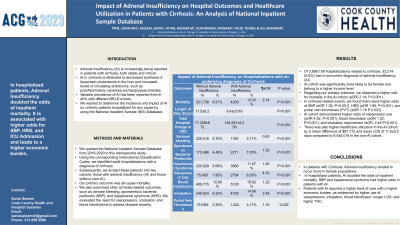Monday Poster Session
Category: Liver
P2444 - Impact of Adrenal Insufficiency on Hospital Outcomes and Healthcare Utilization in Patients With Cirrhosis: An Analysis of National Inpatient Sample Database
Monday, October 23, 2023
10:30 AM - 4:15 PM PT
Location: Exhibit Hall


Sania Saleem, MD
John H. Stroger, Jr. Hospital of Cook County
Chicago, IL
Presenting Author(s)
Chun-Wei Pan, MD1, Sania Saleem, MD1, Bashar Attar, MD2, Ayobami Olafimihan, MD1, Tooba Ayub, MD3, Benjamin Go, MD1
1John H. Stroger, Jr. Hospital of Cook County, Chicago, IL; 2Cook County Health, Chicago, IL; 3Loyola Mcneal Hospital, Berwyn, IL
Introduction: Adrenal Insufficiency (AI) is being reported increasingly in patients with cirrhosis. AI in cirrhosis is attributed to decreased synthesis of lipoprotein cholesterols in the liver and increased levels of circulating endotoxins, such as proinflammatory cytokines and lipopolysaccharides. Variable prevalence of AI has been reported from 6-40% in patients with different MELD scores. We aim to determine the impact of AI on hospitalized cirrhosis patients using the National Inpatient Sample (NIS) Database.
Methods: We queried the NIS Database from 2016-2020 in this retrospective study. Using the corresponding ICD-10 codes, adult hospitalizations with a diagnosis of cirrhosis were identified and divided into two cohorts: those with adrenal insufficiency (AI) and those without (non-AI). Our primary outcome was all-cause mortality. We also examined outcomes, such as variceal bleeding, spontaneous bacterial peritonitis (SBP), and hepatorenal syndrome (HRS). We evaluated the need for vasopressors, intubation, and blood transfusions to assess disease severity.
Results: Of 3,899,159 hospitalizations related to cirrhosis, 32,214 (0.8%) had a concurrent diagnosis of adrenal insufficiency (AI). AI cohort was significantly more likely to be female and belong to a higher income level. The rest of the demographic characteristics and comorbidities were similar between the two cohorts. Regarding our primary outcome, we observed a higher odd for mortality in the AI cohort (aOR) 2.14; P< 0.001). In cirrhosis-related events, we found there were higher odds of SBP (aOR 1.52; P< 0.001), HRS (aOR 1.85; P< 0.001), and portal vein thrombosis (PVT) (aOR 1.16 P 0.022). AI cohort demonstrated higher odds of vasopressor use (aOR 4.52, P< 0.001), blood transfusion (aOR 1.22, P< 0.001), and intubation requirement (aOR: 2.48 P< 0.001). There was also higher healthcare utilization in the AI cohort by a mean difference of $87,712 and a mean LOS difference of 5.1 days.
Discussion: In hospitalized patients with cirrhosis, AI doubled the odds of inpatient mortality. SBP and hepatorenal syndrome had higher odds in patients with AI, and it can be inferred that these conditions may lead to AI development. Patients with AI required a higher level of care with a higher economic burden, as evidenced by higher use of vasopressors, intubation, blood transfusion, longer LOS, and higher THC. Considering poor outcomes, close attention should be paid to developing adrenal insufficiency with timely corticosteroid supplementation.
Disclosures:
Chun-Wei Pan, MD1, Sania Saleem, MD1, Bashar Attar, MD2, Ayobami Olafimihan, MD1, Tooba Ayub, MD3, Benjamin Go, MD1. P2444 - Impact of Adrenal Insufficiency on Hospital Outcomes and Healthcare Utilization in Patients With Cirrhosis: An Analysis of National Inpatient Sample Database, ACG 2023 Annual Scientific Meeting Abstracts. Vancouver, BC, Canada: American College of Gastroenterology.
1John H. Stroger, Jr. Hospital of Cook County, Chicago, IL; 2Cook County Health, Chicago, IL; 3Loyola Mcneal Hospital, Berwyn, IL
Introduction: Adrenal Insufficiency (AI) is being reported increasingly in patients with cirrhosis. AI in cirrhosis is attributed to decreased synthesis of lipoprotein cholesterols in the liver and increased levels of circulating endotoxins, such as proinflammatory cytokines and lipopolysaccharides. Variable prevalence of AI has been reported from 6-40% in patients with different MELD scores. We aim to determine the impact of AI on hospitalized cirrhosis patients using the National Inpatient Sample (NIS) Database.
Methods: We queried the NIS Database from 2016-2020 in this retrospective study. Using the corresponding ICD-10 codes, adult hospitalizations with a diagnosis of cirrhosis were identified and divided into two cohorts: those with adrenal insufficiency (AI) and those without (non-AI). Our primary outcome was all-cause mortality. We also examined outcomes, such as variceal bleeding, spontaneous bacterial peritonitis (SBP), and hepatorenal syndrome (HRS). We evaluated the need for vasopressors, intubation, and blood transfusions to assess disease severity.
Results: Of 3,899,159 hospitalizations related to cirrhosis, 32,214 (0.8%) had a concurrent diagnosis of adrenal insufficiency (AI). AI cohort was significantly more likely to be female and belong to a higher income level. The rest of the demographic characteristics and comorbidities were similar between the two cohorts. Regarding our primary outcome, we observed a higher odd for mortality in the AI cohort (aOR) 2.14; P< 0.001). In cirrhosis-related events, we found there were higher odds of SBP (aOR 1.52; P< 0.001), HRS (aOR 1.85; P< 0.001), and portal vein thrombosis (PVT) (aOR 1.16 P 0.022). AI cohort demonstrated higher odds of vasopressor use (aOR 4.52, P< 0.001), blood transfusion (aOR 1.22, P< 0.001), and intubation requirement (aOR: 2.48 P< 0.001). There was also higher healthcare utilization in the AI cohort by a mean difference of $87,712 and a mean LOS difference of 5.1 days.
Discussion: In hospitalized patients with cirrhosis, AI doubled the odds of inpatient mortality. SBP and hepatorenal syndrome had higher odds in patients with AI, and it can be inferred that these conditions may lead to AI development. Patients with AI required a higher level of care with a higher economic burden, as evidenced by higher use of vasopressors, intubation, blood transfusion, longer LOS, and higher THC. Considering poor outcomes, close attention should be paid to developing adrenal insufficiency with timely corticosteroid supplementation.
Disclosures:
Chun-Wei Pan indicated no relevant financial relationships.
Sania Saleem indicated no relevant financial relationships.
Bashar Attar indicated no relevant financial relationships.
Ayobami Olafimihan indicated no relevant financial relationships.
Tooba Ayub indicated no relevant financial relationships.
Benjamin Go indicated no relevant financial relationships.
Chun-Wei Pan, MD1, Sania Saleem, MD1, Bashar Attar, MD2, Ayobami Olafimihan, MD1, Tooba Ayub, MD3, Benjamin Go, MD1. P2444 - Impact of Adrenal Insufficiency on Hospital Outcomes and Healthcare Utilization in Patients With Cirrhosis: An Analysis of National Inpatient Sample Database, ACG 2023 Annual Scientific Meeting Abstracts. Vancouver, BC, Canada: American College of Gastroenterology.
